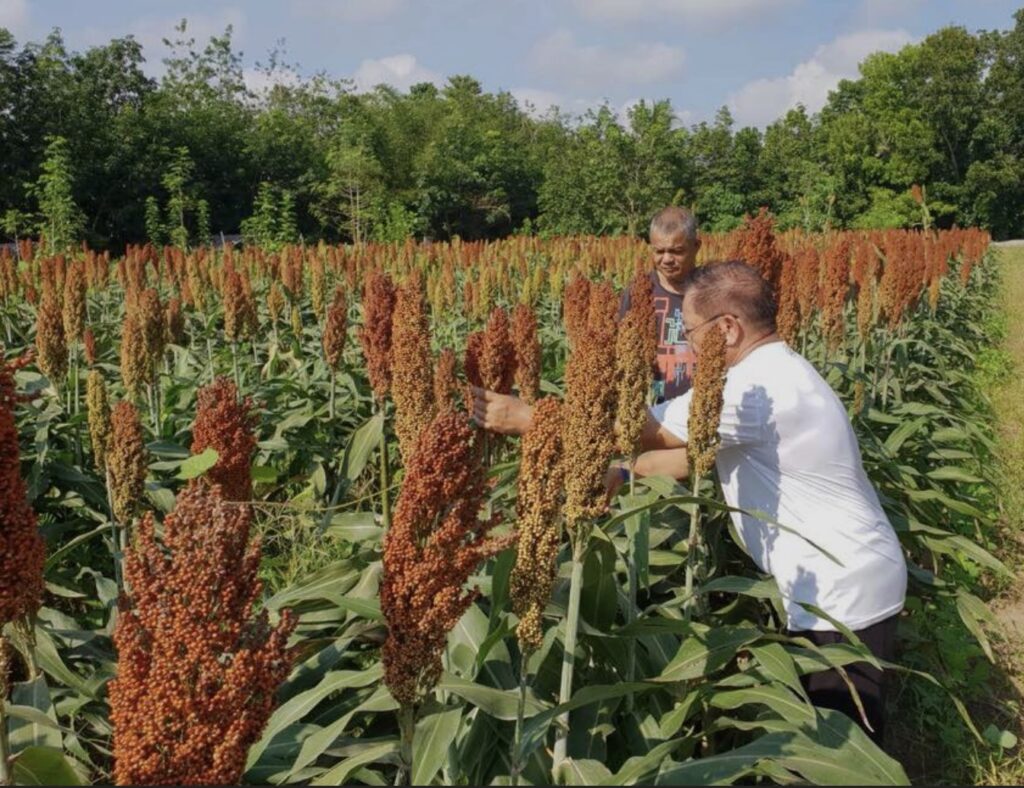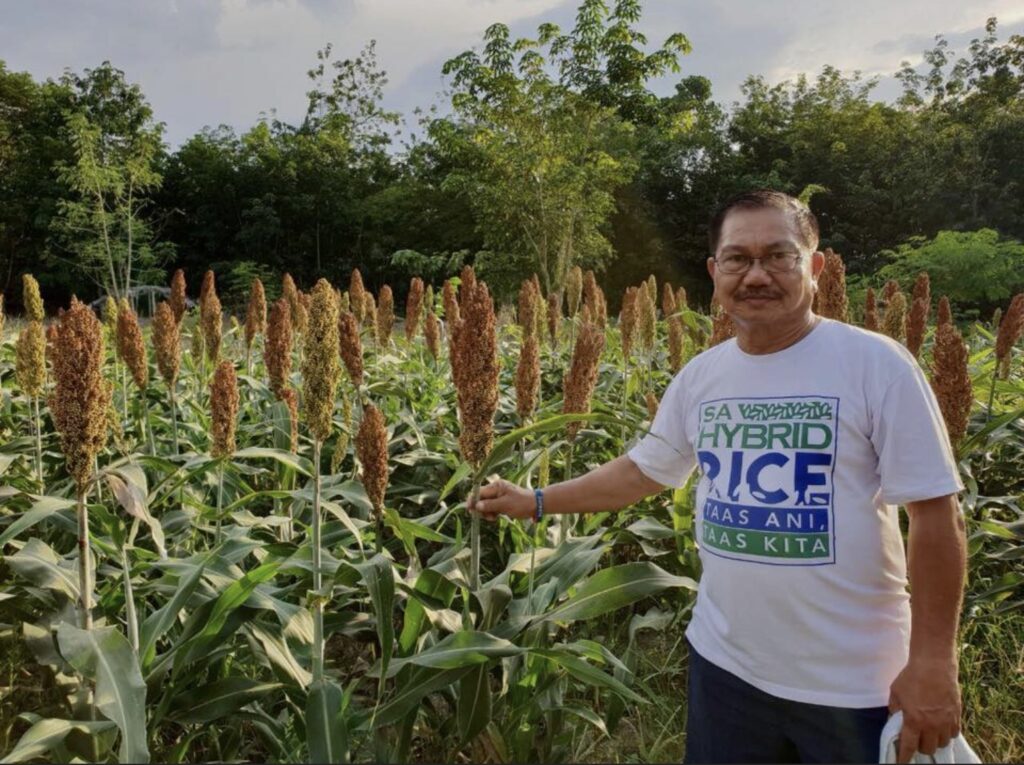By Henrylito D. Tacio
Photos from the Facebook account of Secretary Emmanuel Pinol
The Mindanao Development Authority (MinDA) is encouraging sorghum production as part of its advocacy to reduce poverty among Filipino farmers and increase farm production in the country’s second-largest island.
“With an investment of only about P6,000 per hectare for seeds and 4 bags of fertilizer, a farmer could earn P48,000 gross per harvest,” said MinDA head Emmanuel F. Piñol. “Since sorghum could be ratooned, the farmer could harvest three times with just one planting for a prospective gross income of P144,000 a year.”
In addition, the farmer could have a sufficient supply of silage as the stalks can be used to feed his carabao, cattle, sheep, or goats.
Even if the farmer isn’t able to provide all the recommended requirements to grow sorghum properly, he can still earn half of the projected income. “Still his gross income of P72,000 per year is enough to lift him up the poverty threshold,” Piñol wrote in a social media post.
When he was still the Agriculture Secretary, Piñol re-introduced sorghum to complement the country’s corn production. Since sorghum produces protein-rich grains, it is ideal for livestock and poultry feeds. In fact, studies show sorghum has a higher protein content than corn.
“If 500,000 hectares of Mindanao are planted to sorghum every year with an average production of 4-metric tons with three harvests every year, that would mean 6-million metric tons of grains,” he said.
“That’s a lot of high-protein feeds to boost the livestock and poultry industry of Mindanao,” he pointed out.

The market is not a problem either. Two initial off-takers – Pilmico Foods Corporation and CP Foods Philippines – have agreed to buy sorghum at a farm gate price of P12 per kilogram. “That would mean an additional P72-billion a year generated by Mindanao agriculture,” Piñol said.
According to Piñol, sorghum was introduced in the country some 40 years ago, but it had not taken off. “(Sorghum) never really gained popularity as a source of protein for animals because of the absence of support from the government,” he lamented.
Even before Piñol re-introduced sorghum, the National Academy of Science and Technology (NAST) was already promoting it as “the next crop that will bring income to farmers.”
A focus group discussion was convened by NAST, an advisory body of the Department of Science and Technology, in 2013 in Ilocos Norte as tobacco farmers were trying to find an alternative crop for tobacco.
“Tobacco farmers will lose their jobs if taxes will increase, and demand for tobacco products will slow down,” Dr. Heraldo L. Layaoen of Mariano Marcos State University was quoted as saying. “We have a ready substitute for this – sorghum.”
According to Dr. Layaoen, the crop’s profitability can turn the tide in favor of tobacco farmers who use too many pesticides to protect the leaves. But that is just one of the many issues of tobacco growing.
Ilocos Norte, he pointed out, is ideal for growing sorghum because of its long dry season. Sweet sorghum, the recommended variety, requires less water. Studies show it needs only 35% of the water needed by corn.
When he re-introduced sorghum production, Piñol was targeting areas that are planted to coconut, where it can be integrated as a secondary crop and in ancestral domain areas and land currently planted to upland rice.

“Because of its versatility and adaptation, sorghum is one of the really indispensable crops required for the survival of mankind,” wrote Jack Harlan, an American campaigner for crop plant biodiversity conservation, in 1971. Unfortunately, many of those who are not in the agriculture industry have either never heard of the sorghum or are unsure about it.
In the 19th century Ethiopia, Richard Pankhurst reported that durra – as sorghum is known in the said country – was “often the first crop sown on newly cultivated land,” explaining that the African grass did not require the thorough plowing just like other crops. Its roots not only decomposed into a good fertilizer, but they also helped to break up the soil while not exhausting the subsoil.
There are several species of sorghum, which are grown in various parts of the world. After rice, wheat, corn, and barley, sorghum is the world’s fifth-most important cereal crop. The most widely cultivated is sweet sorghum (scientific name: Sorghum bicolor).
The Bureau of Agricultural Research (BAR), a line agency of the Department of Agriculture, described sweet sorghum as “the great climate crop.” BAR’s Rita T. Dela Cruz wrote: “Sweet sorghum is a resilient crop. It is easy to grow, and is resistant to pests and weed. It tolerates soil salinity, acidity and toxicity, and can withstand extremes of tropical weather, tolerating both heat and water logging.”
And that’s not all. “Given its resiliency and adaptability to changing climates, sweet sorghum thrives even in marginal, arid lands which cannot be planted to rice, corn or sugarcane. Hence, sweet sorghum is great solution to soil problems,” Dela Cruz wrote.
In the past, sorghum was promoted as a major source of bioethanol to address the country’s energy problem. Bioethanol – a form of renewable energy produced mostly from biomass – is ethyl alcohol used as a fuel, particularly as an additive for gasoline in motor fuel.
“The main source of ethanol is the stalks which when crushed yields sweet juice that can be fermented and distilled to obtain bioethanol – a clean burning fuel with a high-octane rating,” Dela Cruz wrote. “With this technology at hand, the Philippines can go all out for the 10% bioethanol-blended gasoline to save an estimated 565 million liters of gasoline per year.”
But aside from that, sorghum can also provide three other F’s: food, feed/forage, and fertilizer. “We consider sweet sorghum an ideal ‘smart crop’ because it produces food as well as fuel,” said Agriculture Secretary William D. Dar, who was previously the director-general of the India-based International Crops Research Institute for the Semi-Arid Tropics. “Sweet sorghum can help meet the country’s fuel needs without compromising our food supply.”
Food comes from the grains. “(Sweet sorghum) is a promising cereal crop that could help address problems on malnutrition, dwindling food supply, and the increasing cost of wheat flour,” Dela Cruz assumed. “It can be milled into flour as the main ingredient for soups and porridge, native delicacies, meals, and appetizers. The grains can be processed and used as an alternative to rice.”
In the United States, sorghum finds its way in the gluten-free market. In the southern part, it is popular as a “staple sweetener.” Chef and cookbook author Edward Lee describes the sweetener as having a unique flavor. “It adds a lot of depth to what you’re cooking, more so than honey.”
Sorghum packs healthy benefits in every grain. Britannica gives this bit of information: “Sorghum is high in carbohydrates, with 10% protein and 3.4% fat, and contains calcium and small amounts of iron, vitamin B1 and niacin.”
As a feed, sorghum is commendable. “Although it is lower in vitamin A, sorghum grain is similar to corn,” Dela Cruz wrote. “When compared with corn on a per pound basis, sorghum’s feeding value ranges from 90% to nearly equal that for corn. The grain is highly palatable to livestock and its intake seldom limits livestock productivity. The grains have also been found to be an essential ingredient in the production of pre-conditioner feeds for fighting cocks.”
The stalks and leaves are also excellent forage. “The stripped leaves and crushed stalks of sweet sorghum are also good for large and small ruminants,” Dela Cruz wrote. “The leaves and fibrous residue contain large quantities of protein, making it a valuable livestock feed.”
The pulp or dry refuse left after the juice is extracted from sweet sorghum can be converted into bio-organic fertilizer. Introducing Trichoderma harzianum, a microbial inoculant, composting time can be shortened from three months to just 3-4 weeks. 25,000 kilograms of sweet sorghum bagasse can produce 125 bags of bio-organic fertilizer, Dela Cruz said.

